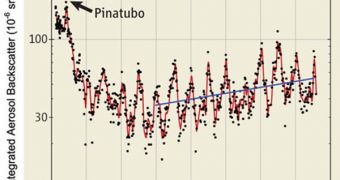Over the past few decades, our civilization has released billions of tons of carbon dioxide and other greenhouse gases, including sulfur, into the atmosphere, generating what in the 1970s and 1980s came to be known as the “human volcano” effect. However, it has been widely believed until now that only volcanoes spilling ash and other materials are strong enough to penetrate up to the higher reaches of the stratosphere. In a paper recently published, experts offer proof that proves the opposite to be true.
Publishing in the prestigious scientific journal Geophysical Research Letters, experts from the University of Colorado in Boulder, led by Atmospheric Scientist David Hofmann, show that greenhouse gases, including sulfur and carbon dioxide, may have the ability to considerably penetrate the atmosphere, breaking through the barrier of its lower part. The team used Light Detection and Ranging (LIDAR) devices in their experiments.
They have surveyed the skies over Mauna Kea, in Hawaii, as well as those over Boulder, Colorado, ever since 2000. This device functions by bouncing electromagnetic waves off the particles the emitted ray meets in the atmosphere and stratosphere. The researchers describe an ascending trend over the course of seven years, as far as the amounts of fine particles and soot in the upper atmosphere go. This kind of particles is now so widespread, that it forms a haze stretching around the world. However, it's most visible in China, the world's biggest polluter, where it can be viewed from a satellite.
However, the experts also caution that there may exist other possible explanations for the increase in the amount of soot found high in the air. They say that the constant upwards trend may be determined by an increase in the amount of upwards air drafts, which have the ability to carry fine particles in the stratosphere, in very much the same way a volcano's ash plume does the same. The increased speed at which this is happening may be caused by a natural phenomenon, or it may be a consequence of global warming, ScienceNow informs.

 14 DAY TRIAL //
14 DAY TRIAL //